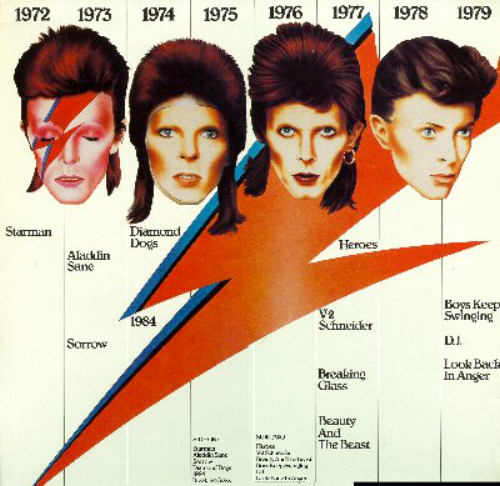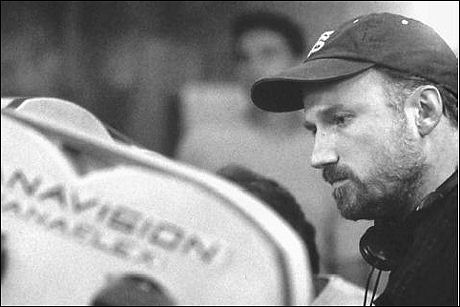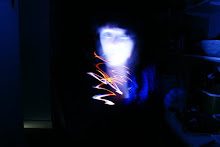
Wednesday 8 July 2009
Music Artist Case Study

For this case study I am going to be focusing on a musician who frequently reinvented his music and image. He is known for his distinctive voice and the intellectual depth of his work.
David Robert Hayward-Jones (8th January 1947, is an English musician, actor, record producer and arranger. He has been active in five decades of music. Bowie is widely regarded as an innovator mostly for his work in the '70s.
The Beginning
David Bowie first caught the eye of the general public in the autumn of '69, with the song Space Oddity.
- This early version of the video was part of Bowie's promotional film, Love You Till Tuesday.
- Oddity is about the launch of Major Tom, a fictional astronaunt.
- The BBC features the song in its television coverage of the lunar landing.
- It reached the top five of the UK singles chart.
Bowie split from record label Dream, his manager Kenneth Pitt negotiated a one-album deal with Mercury Records and Philips in 1969. A potiental producer George Martin turned the project down Bowie stumbled across Tony Visconti who liked the album demo-tracks, but considered Oddity as a gimmick track. The production was then handed over to Gus Dudgeon.
Bowie first sparked an interest in music at the mere age of 9, listening to his father's records. During the early 1960's Bowie was performing under his own name or the stage name "Davie Jones". This created confusion with Davy Jones of The Monkees. He then chose "Bowie" for his stage name, and released his first album in 1967 for the Decca Records, David Bowie spanning the genres pop, psychdelia and music hall.
He was influenced by the dramatic arts and studied from avant-garde theatre and mime to Commedia dell'arte. His work involves the creation of characters and personae to present to the world alongside music. Bowie sold his first song in '67 to another artist Oscar (very early stage name of actor/musician Paul Nicholas).
- - - - - - - - - - - - - -
70's
- Bowie released his third album, The Man Who Sold The World in 1970. Collaborating with Mick Ronson for the first of many times. The cover shows Bowie in a dress, this is a very early example of his androgynous appearance.
- His next album Hunky Dory 1971 (one of his best albums in my opinion) explores more serious themes on tracks such as the semi-autobiographical The Bewlay Brothers and the Buddhist-influenced Quicksand. He paid direct homage to his influences with Song for Bob Dylan, and Andy Warhol. The album was not a big hit but it laid groundwork for the move that lifted Bowie into the first rank of stars.
- He then further explored his persona in June 1972with concept album The Rise and Fall of Ziggy Stardust and the Spiders from Mars which present a world destined to end in five years and it tells the story of rock star, Ziggy Stardust. Some of what are considered to be Bowie's classics stem from this album such as: Ziggy Stardust and Suffragette City.
- Bowie began promoting and producing with several of his heroes and influences. He has worked with the likes of Lou Reed and Iggy Pop. Thanks to Bowie Iggy's band The Stooges signed with Bowie's management (MainMan Productions).
- In 1973 the Spiders From Mars came together again on Aladdin Sane. The album includes the UK #2 hit The Jean Genie and the #3 hit Drive-In Saturday.
- 1974 saw the release of another ambitious album, Diamond Dogs.
- His next album Hunky Dory 1971 (one of his best albums in my opinion) explores more serious themes on tracks such as the semi-autobiographical The Bewlay Brothers and the Buddhist-influenced Quicksand. He paid direct homage to his influences with Song for Bob Dylan, and Andy Warhol. The album was not a big hit but it laid groundwork for the move that lifted Bowie into the first rank of stars.
- He then further explored his persona in June 1972with concept album The Rise and Fall of Ziggy Stardust and the Spiders from Mars which present a world destined to end in five years and it tells the story of rock star, Ziggy Stardust. Some of what are considered to be Bowie's classics stem from this album such as: Ziggy Stardust and Suffragette City.
- Bowie began promoting and producing with several of his heroes and influences. He has worked with the likes of Lou Reed and Iggy Pop. Thanks to Bowie Iggy's band The Stooges signed with Bowie's management (MainMan Productions).
- In 1973 the Spiders From Mars came together again on Aladdin Sane. The album includes the UK #2 hit The Jean Genie and the #3 hit Drive-In Saturday.
- 1974 saw the release of another ambitious album, Diamond Dogs.
- Bowie achieved his first major American crossover success in 1975 with the number-one single Fame. Co-written with John Lennon, the song stems from the hit album Young Americans. The sound constituted a radical shift in style that initially caught the attention of Bowie's UK devotees. Lennon's voice can be heard at the end repeating the word FAME.
- Station to Station 1976 featured a darker version of this soul persona called "The Thin White Duke". Visually it was an extention of Thomas Jerome Newton (the character he played in The Man Who Fell to Earth)
- Station to Station 1976 featured a darker version of this soul persona called "The Thin White Duke". Visually it was an extention of Thomas Jerome Newton (the character he played in The Man Who Fell to Earth)
- - - - - - -
80's
80's
- Scary Monsters (and Super Creeps), included the hit single Ashes to Ashes. The imagery used in the video gave international exposure to the underground New Romantic movement.
- 1981 Under Pressure, co-written and performed with Queen was released.
- In 1983 Bowie scored his first commerical blockbuster with Let's Dance. The album features hits: Modern Love and China Girl.
- 1984's album Tonight also dance-oriented, featured collobarations with the likes of Tina Turner and Iggy Pop. It also included various covers including one of The Beach Boys song, God Only Knows.
- 1981 Under Pressure, co-written and performed with Queen was released.
- In 1983 Bowie scored his first commerical blockbuster with Let's Dance. The album features hits: Modern Love and China Girl.
- 1984's album Tonight also dance-oriented, featured collobarations with the likes of Tina Turner and Iggy Pop. It also included various covers including one of The Beach Boys song, God Only Knows.
- Bowie's final solo album of the 80's was 1987's Never Let Me Down. He ditched the light sound of his two earlier albums and offered a techno dance edge to his music. The album contained hit singles Day In, Day Out, Time Will Crawl and Never Let Me Down. Bowie then described it as "my nadir" and "an awful album".
- For the first time since the early 1970s, in 1989 Bowie formed a regular band, Tin Machine. Tin Machine released two studio albums and a live record. The band recieved mixed reviews and a reception from the public. The original album Tin Machine was a success holding the number three spot on the charts of the U.K.
- After the less successful second album Tin Machine II and the complete failure oft he live album Tin Machine Live he disbanded Tin Machine to work on his own.
- In 1993 Bowie explored once again new directions with The Buddha of Suburbia, based on incidental music composed for a TV series. It contained some elements explored in the album before, Black Tie, White Noise.
- In 1995 he released an album Outside, another collaboration with Brian Eno.
- In 1997, Bowie received some of the strongest critical response since Let's Dance with Earthling.
- In 1997, Bowie received some of the strongest critical response since Let's Dance with Earthling.
- In 1999 Hours was released featured new versions of some of his earliest pieces as well as three new songs.
- Then in 2002 Bowie collaborated with Visconti on the album Heathen.
- In 2003 Bowie released an album Reality and announced a world tour.
Sunday 5 July 2009
Music Video Directors
 David Fincher is an American film/music video director. Known for his dark movies such as: Se7en and Fight Club.
David Fincher is an American film/music video director. Known for his dark movies such as: Se7en and Fight Club.How Fincher made it
- Son of Jack Fincher (a chief and writer for Life magazine.
- Began making movies at 8 with a 8mm camera.
- Started off by getting a job loading cameras for John Korty (Korty Films).
- Was then hired by Industrial Light & Magic in 1980, where he worked on productions such as Indiana Jones and the Temple of Doom and Return of the Jedi.
- Left in '84 to direct a commercial for the American Cancer Society.
- Producers in LA spotted him and was given the chance to direct the documentary The Beat of the Live Drum, in 1985.
- Work with companies like Revlon, Converse, Nike, Pepsi, Sony and Levi's.
- Fincher soon discovered music videos and went on to direct many promos.
- Joined video-production company, Propaganda Films and started off directing music videos and commercials.
Some of his most famous work..
Vogue - Madonna
Shot at The Burbank Studios in California on February -10 1990. Filmed in black-and-white, the video pays visual reference to the look of the 1930s Hollywood films with the use of artwork by Tamara de Lempicka (Art Deco). Many of the scenes were recreations of photo
 graphs taken by the noted photographer Horst P. Horst, including his famous "Mainbocher Corset" (right). Some of the close-up poses pay homage to stars like: Marilyn Monroe, Veronica Lake and Marlene Diethrich.
graphs taken by the noted photographer Horst P. Horst, including his famous "Mainbocher Corset" (right). Some of the close-up poses pay homage to stars like: Marilyn Monroe, Veronica Lake and Marlene Diethrich.There was some controversy surrounding the video (as Madonna loves abit of controversy) due to a scene where Madonna's breasts could be seen through her blouse.
This video was the third time Fincher and Madonna collaborated. Their first colaboration was in 1989 with "Express Yourself"
and their second collaboration was again in the same year with "Oh Father".
Subscribe to:
Posts (Atom)






